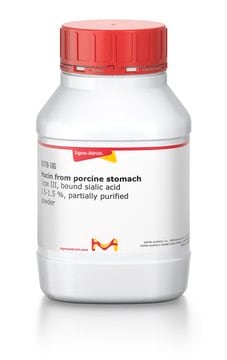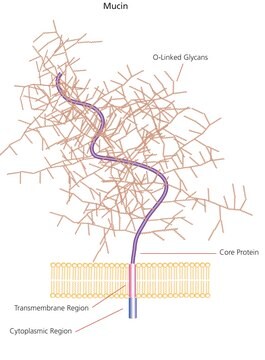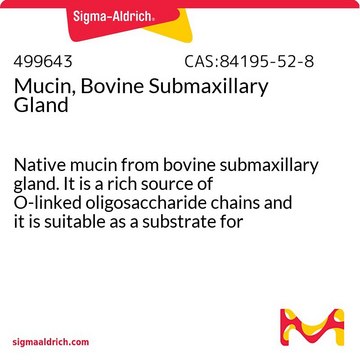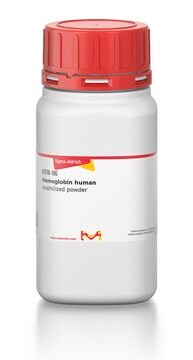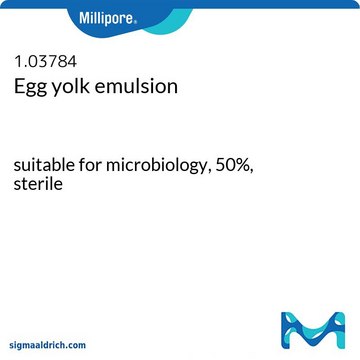M2378
Mucin from porcine stomach
Type II
Synonym(s):
MUC
Sign Into View Organizational & Contract Pricing
All Photos(2)
About This Item
Recommended Products
biological source
Porcine stomach
type
Type II
form
powder
composition
bound sialic acid, ≤1.2%
technique(s)
cell culture | mammalian: suitable
solubility
1 M NaOH: soluble 20 mg/mL
UniProt accession no.
storage temp.
2-8°C
Gene Information
pig ... MUC2(100127145)
Looking for similar products? Visit Product Comparison Guide
General description
Mucin is majorly composed of carbohydrate units, crucial for structural architecture and conformation. The monomer of mucin is 640 kDa, with protein contributing to only 20% of the molecular weight. The carbohydrate component is attached to the threonine and serine side chains. Mucins are classified into secreted and transmembrane mucins.
Mucins or mucus glycoproteins are the main macromolecular components of mammalian mucus. It was also used in a study to evaluate the sputum smears concentrated by cyto-centrifugation for detection of acid-fast bacilli.
Application
Mucin from porcine stomach has been used:
- in the standard curve generation for quantifying mucin-2 generated during mucosal inflammation in mice
- as a component of digestion fluid solutions in in vitro human digestion model
- as a component of simulated saliva fluid
Mucin from porcine stomach was used in studies on the binding site of the galactose-specific agglutinin PA-IL from Pseudomonas aeruginosa.
Biochem/physiol Actions
Mucin has wide pharmacological applications in drug delivery. Mucins play a protective role in inflammation. Deregulation in mucin synthesis contributes to tumorigenesis and chronic inflammation.
Mucus forms the protective cover for all epithelial surfaces. The major structural component of mucus is gel-forming mucins. The mucus layer covering the intestinal epithelium has the MUC2 mucin as its central molecule. MUC2 is produced by goblet cells.
Storage Class Code
11 - Combustible Solids
WGK
WGK 3
Flash Point(F)
Not applicable
Flash Point(C)
Not applicable
Personal Protective Equipment
dust mask type N95 (US), Eyeshields, Gloves
Choose from one of the most recent versions:
Already Own This Product?
Find documentation for the products that you have recently purchased in the Document Library.
Customers Also Viewed
Amparo Gamero et al.
Foods (Basel, Switzerland), 8(5) (2019-05-06)
The aim of the present study was to determine how variation in the biscuit matrix affects both the degree of in vitro fragmentation and the starch hydrolysis that occurs during the oral phase of digestion. Using three different oat ingredient
Genetic mouse models with intestinal-specific tight junction deletion resemble an ulcerative colitis phenotype
Stremmel W, et al.
Journal of Crohn's & Colitis, 11(10), 1247-1257 (2017)
Maria Schei Haugan et al.
Scientific reports, 8(1), 14961-14961 (2018-10-10)
The efficacy of most antibiotics is dependent on active bacterial growth, yet little is known about the growth dynamics during infection. Therefore, means to measure in-host bacterial growth rate is of importance. Here, we use chromosome replication as readout for
Enhancement of the solubility, stability and bioaccessibility of quercetin using protein-based excipient emulsions
Chen X, et al.
Food Research International, 114, 30-37 (2018)
Mucins in cancer: function, prognosis and therapy
Kufe DW
Nature Reviews. Cancer, 9(12), 874-874 (2009)
Articles
Review article and products for sialic acid synthesis and signaling.
Our team of scientists has experience in all areas of research including Life Science, Material Science, Chemical Synthesis, Chromatography, Analytical and many others.
Contact Technical Service